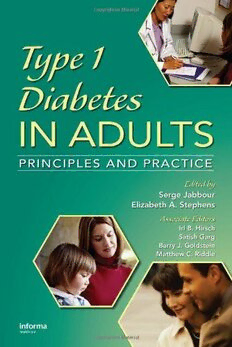
Type 1 Diabetes in Adults: Principles and Practice PDF
282 Pages·2007·4.219 MB·English
Most books are stored in the elastic cloud where traffic is expensive. For this reason, we have a limit on daily download.
Preview Type 1 Diabetes in Adults: Principles and Practice
Description:
Both clinicians and patients have a need for accurate information about adult-onset Type 1 diabetes (both rapid onset and slow onset). Although this new book, Type 1 Diabetes in Adults: Principles and Practices, contains some good information, the book also continues to promote myths about Type 1 diabetes that are disputed by sound scientific research that is published in peer-reviewed medical journals, and the book does not address critical issues facing those who acquire Type 1 diabetes as adults.
Probably the most significant problem faced by people with adult-onset autoimmune diabetes is being misdiagnosed as having Type 2 diabetes, and not being treated with exogenous insulin at diagnosis, which is the standard of care for those with Type 1 diabetes. This book does not address that problem nor provide any solutions to that problem. Misdiagnosis typically results in substandard treatment, where doctors try to use oral medications (without insulin) to control blood glucose levels, and the substandard treatment often results in early onset of diabetic complications (potentially within months of misdiagnosis) and needless suffering on the part of the person with Type 1 diabetes.
Unfortunately, discrepancies and wrong information about adult-onset Type 1 diabetes abound in Type 1 Diabetes in Adults. The book states at least three different figures for the numbers of people with Type 1 diabetes in the U.S., yet every single one of those figures comes from studies that excluded those with slow-onset Type 1 diabetes in adults, who according to two of the authors represent two to three times the numbers of childhood-onset Type 1 diabetes (p. 27). Then, Chapter 13 ("Psychological Aspects of Type 1 Diabetes in Adults" ) states that "most adults with Type 1 diabetes are diagnosed as children or adolescents." Again, it is no wonder that the myth that Type 1 diabetes is a childhood disease lives on, when such wrong information is presented.
In Chapter 2 of the book, the authors state that "The relatively high incidence rate of Type 1 diabetes in adults is often not appreciated, probably because of the more than 10-fold greater frequency of Type 2 diabetes in this age group." I would propose that misinformation spread by those in the medical community leads to the lack of acknowledgement of the true numbers of adult-onset Type 1 diabetics. For example, the Type 1 diabetes TrialNet website states, "5 to 10 percent of all people with diabetes have type 1 diabetes" and "this type of diabetes occurs more often in children and young adults." The Joslin Diabetes Center website states that, "People may develop type 1 diabetes at any age, but it is frequently diagnosed before adulthood. [Type 1 diabetes] accounts for about 5%-10% of all diabetes cases." Yet those percentages exclude those with slow-onset Type 1 diabetes, and in fact Type 1 diabetes represents about 15-25% of all cases of diabetes if all Type 1 autoimmune diabetes cases are included in the percentages. If institutions such as NIH/NIDDK and Joslin provide such incorrect information about Type 1 diabetes, it is no wonder that the high incidence of Type 1 diabetes in adults (two to three times that of childhood-onset Type 1 diabetes, according to the book authors) is not appreciated.
TrialNet, a large ongoing study of Type 1 diabetes, excludes people based on age, not type of diabetes. The TrialNet website states TrialNet "is dedicated to the study, prevention, and early treatment of type 1 diabetes." If that is the case, why are newly diagnosed Type 1 diabetics with age of onset over age 45 excluded from the prevention studies? Why is it that relatives of a Type 1 diabetic are excluded from the family history studies if the diagnosis of Type 1 diabetes was after age 40? For the TrialNet Type 1 Diabetes Genetics Consortium study, relatives of someone with Type 1 diabetes are excluded from the study if the Type 1 diabetic was diagnosed over age 35. Because TrialNet is excluding a huge number of people with Type 1 diabetes because of their age at diagnosis, the studies are not truly representative of Type 1 diabetes, only Type 1 diabetes below a certain age.
What is actually needed for those with adult-onset Type 1 diabetes?
1) Correct diagnosis (i.e., not misdiagnosed as Type 2)
2) Immediately initiation of intensive insulin therapy, to preserve remaining beta cell mass
3) Appropriate Type 1 diabetes education geared towards adults
4) Inclusion in clinical trials and studies
5) Inclusion in percentages of Type 1 diabetes.
This book is useful in some respects but does not address key issues for those who acquire Type 1 diabetes as adults. I do not believe that a definitive book on Type 1 diabetes in adults has been written yet.
See more
The list of books you might like
Most books are stored in the elastic cloud where traffic is expensive. For this reason, we have a limit on daily download.
